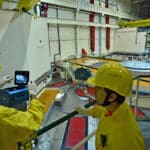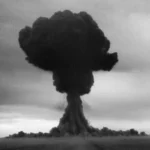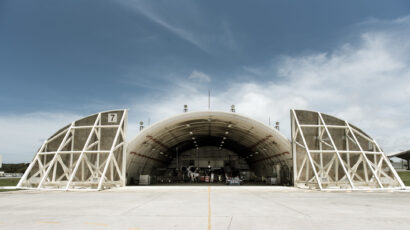Nuclear Notebook: United States nuclear weapons, 2023
By Hans M. Kristensen, Matt Korda, January 16, 2023
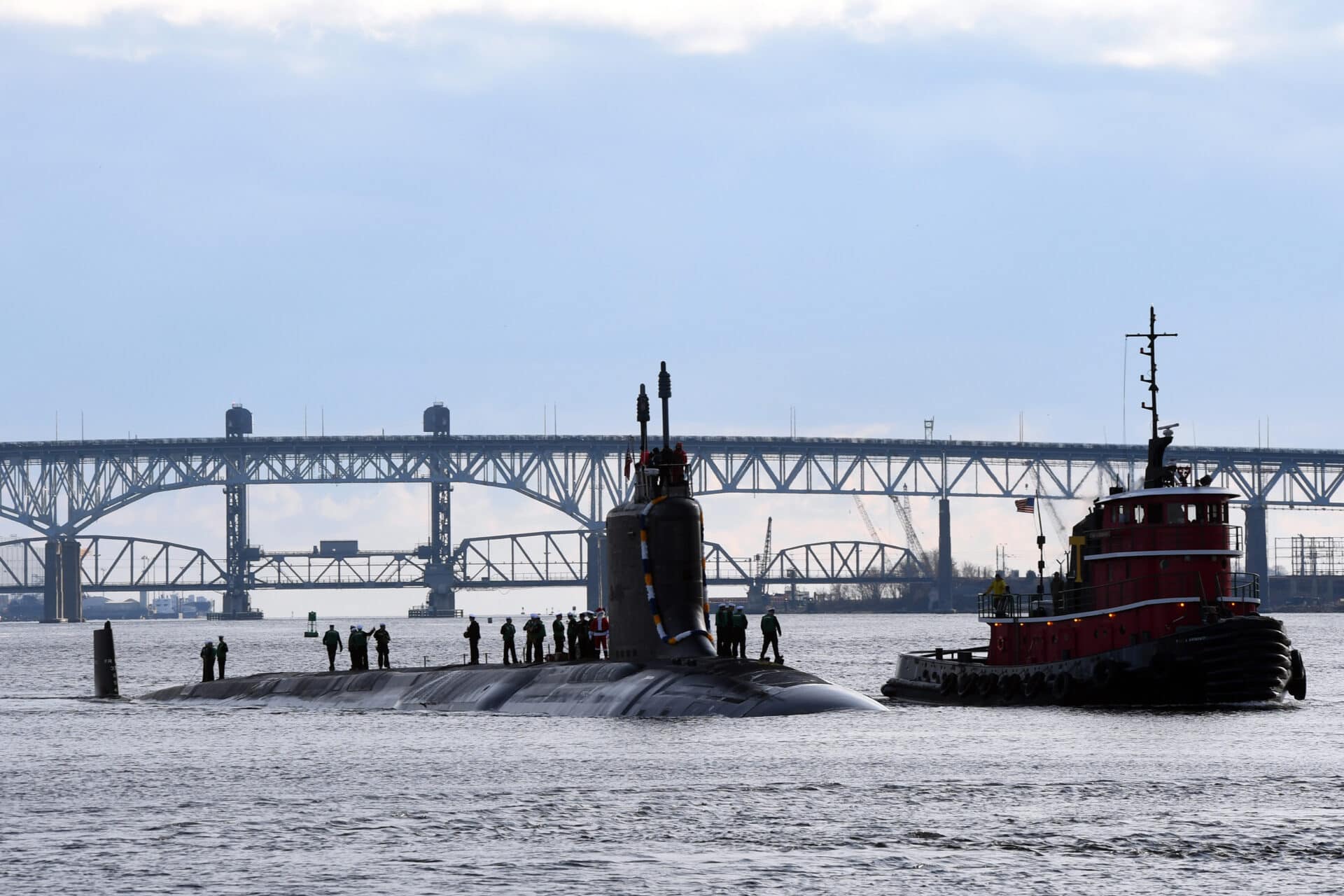
The USS South Dakota sails up the Thames River in Connecticut during a homecoming event at Naval Submarine Base New London in Groton, CT, on December 18, 2022. The submarine returned from a five-month deployment. Photo By: Navy Chief Petty Officer Joshua Karsten, image courtesy US Department of Defense.
The Nuclear Notebook is researched and written by Hans M. Kristensen, director of the Nuclear Information Project with the Federation of American Scientists, and Matt Korda, a senior research associate with the project. The Nuclear Notebook column has been published in the Bulletin of the Atomic Scientists since 1987. This issue examines the status of the US nuclear arsenal. The US nuclear arsenal remained roughly unchanged in the last year, with the Department of Defense maintaining an estimated stockpile of approximately 3,708 warheads. Of these, only about 1,770 warheads are deployed, while approximately 1,938 are held in reserve. Additionally, approximately 1,536 retired warheads are awaiting dismantlement, giving a total inventory of approximately 5,244 nuclear warheads. Of the approximately 1,770 warheads that are deployed, 400 are on land-based intercontinental ballistic missiles, roughly 970 are on submarine-launched ballistic missiles, 300 are at bomber bases in the United States, and 100 tactical bombs are at European bases.
This article is freely available in PDF format in the Bulletin of the Atomic Scientists’ digital magazine (published by Taylor & Francis) at this link. To cite this article, please use the following citation, adapted to the appropriate citation style: Hans M. Kristensen & Matt Korda, The long view: Strategic arms control after the New START Treaty, 2022, Bulletin of the Atomic Scientists, 79:1, 28-52, DOI: https://doi.org/10.1080/00963402.2022.2156686
To see all previous Nuclear Notebook columns, go to https://thebulletin.org/nuclear-notebook.
At the beginning of 2023, the US Department of Defense maintained an estimated stockpile of approximately 3,708 nuclear warheads for delivery by ballistic missiles and aircraft. Most of the warheads in the stockpile are not deployed but rather stored for potential upload onto missiles and aircraft as necessary. We estimate that approximately 1,770 warheads are currently deployed, of which roughly 1,370 strategic warheads are deployed on ballistic missiles and another 300 at strategic bomber bases in the United States. An additional 100 tactical bombs are deployed at air bases in Europe. The remaining warheads — approximately 1,938 — are in storage as a so-called hedge against technical or geopolitical surprises. Several hundred of those warheads are scheduled to be retired before 2030. (See Table 1.)
In addition to the warheads in the Department of Defense stockpile, approximately 1,536 retired — but still intact — warheads are stored under the custody of the Department of Energy and are awaiting dismantlement, giving a total US inventory of an estimated 5,244 warheads. Between 2010 and 2018, the US government publicly disclosed the size of the nuclear weapons stockpile; however, in 2019 and 2020, the Trump administration rejected requests from the Federation of American Scientists to declassify the latest stockpile numbers (Aftergood 2019; Kristensen 2019a, 2020d). In 2021, the Biden administration restored the United States’ previous transparency levels by declassifying both numbers for the entire history of the US nuclear arsenal until September 2020 — including the missing years of the Trump administration. This effort revealed that the United States’ nuclear stockpile consisted of 3,750 warheads in September 2020 — only 72 warheads fewer than the last number made available in September 2017 before the Trump administration reduced the US government’s transparency efforts (US State Department 2021a). We estimate that the stockpile will continue to decline over the next decade-and-a-half as modernization programs consolidate the remaining warheads.
The Biden administration’s declassification also revealed that the pace of warhead dismantlement has slowed significantly in recent years. While the United States dismantled on average more than 1,000 warheads per year during the 1990s, in 2020 it dismantled only 184 warheads (US State Department 2021a). According to the Department of Energy, “[d]ismantlement rates are affected by many factors, including appropriated program funding, logistics, legislation, policy, directives, weapon system complexity, and the availability of qualified personnel, equipment, and facilities” (US Department of Energy 2022, 2–15). The Department of Energy’s 2022 Stockpile Stewardship and Management Plan indicated that the United States is currently “on pace to completely dismantle the weapons that were retired at the end of FY 2008 by the end of FY 2022” (US Department of Energy 2022, 2–15).
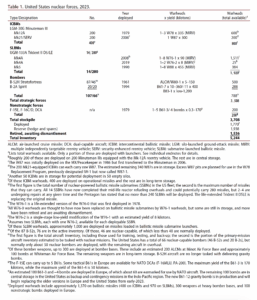
In the past, the Obama and Biden administrations often declassified the warhead stockpile and dismantlement numbers around the time of major arms control conferences. That did not happen in 2022, however, and the Biden administration has so far not acted on requests from the Federation of American Scientists to disclose the numbers for 2021 or 2022. A decision to no longer declassify these numbers would not only contradict the Biden administration’s own practice from 2020, but also represent a return to Trump-era levels of nuclear opacity. Such increased nuclear secrecy undermines US calls for Russia and China to increase transparency of their nuclear forces.
The US nuclear weapons are thought to be stored at an estimated 24 geographical locations in 11 US states and five European countries (Kristensen and Korda 2019, 124). The location with the most nuclear weapons by far is the large Kirtland Underground Munitions and Maintenance Storage Complex (KUMMSC) south of Albuquerque, New Mexico. Most of the weapons in this location are retired weapons awaiting dismantlement at the Pantex Plant in Texas. The state with the second-largest inventory is Washington, which is home to the Strategic Weapons Facility Pacific and the ballistic missile submarines at Naval Submarine Base Kitsap. The submarines operating from this base carry more deployed nuclear weapons than any other base in the United States.
Implementing the New START treaty
The United States appears to be in compliance with the New Strategic Arms Reduction Treaty (New START) limits. The most recent data exchange, on September 1, 2022, indicated that the United States deployed 659 strategic launchers with 1,420 attributed warheads (US State Department 2022a). This is a decrease of six deployed strategic launchers and an increase of 31 attributed warheads over the past 12 months. However, these changes do not reflect actual changes in the US arsenal but are caused by normal fluctuations from launchers moving in and out of maintenance. The United States has not reduced its total inventory of strategic launchers since 2017 (Kristensen 2020a).
The warhead numbers reported by the US State Department differ from the estimates presented in this Nuclear Notebook, though there are reasons for this. The New START counting rules artificially attribute one warhead to each deployed bomber, even though US bombers do not carry nuclear weapons under normal circumstances. Also, this Nuclear Notebook counts weapons stored at bomber bases that can quickly be loaded onto the aircraft, as well as nonstrategic nuclear weapons in Europe. This provides a more realistic picture of the status of US nuclear forces than the treaty’s artificial counting routes.
Since the treaty entered into force in February 2011, the biannual aggregate data show the United States has cut a total of 324 strategic launchers, 223 deployed launchers, and 380 deployed strategic warheads from its inventory (US State Department 2011). The warhead reduction represents approximately 11 percent of the 3,708 warheads remaining in the US stockpile, and approximately 8 percent of the total US arsenal of 5,428 stockpiled and retired warheads awaiting dismantlement. The 2022 Nuclear Posture Review (NPR) states that the “[t]he United States will field and maintain strategic nuclear delivery systems and deployed weapons in compliance with New START Treaty central limits as long as the Treaty remains in force” (US Department of Defense 2022b, 20). In 2021, the United States and Russia extended the treaty by mutual agreement, until February 2026.
The United States is currently 41 launchers and 130 warheads below the treaty limit for deployed strategic weapons but has 119 deployed launchers more than Russia — a significant gap that is just under the size of an entire US Air Force intercontinental ballistic missile (ICBM) wing. It is notable that Russia has not sought to reduce this gap by deploying more strategic launchers. Instead, the Russian launcher deficit has increased since February 2018.
If New START expired without a follow-on treaty in place, both the United States and Russia could upload several hundred extra warheads onto their launchers. This means that the treaty has proven useful thus far in keeping a lid on both countries’ deployed strategic forces. Additionally, both countries would lose a critical node of transparency into each other’s nuclear forces. As of December 8, 2022, the United States and Russia had completed a combined 328 on-site inspections and exchanged 25,017 notifications (US State Department 2022b).
On-site inspections between the two countries have been paused since early 2020 due to COVID-19, and on August 8, 2022, Russia announced that it was “temporarily withdrawing its facilities subject to inspections” because of what it claimed was unfair behavior by the United States (Russian Federation Ministry of Foreign Affairs 2022). Moreover, only one day before a long-awaited meeting of the Bilateral Consultative Commission, Russia delayed the meeting because of US arms supplies to Ukraine (Dixon 2022).
The Nuclear Posture Review and nuclear modernization
The classified version of the Biden administration’s Nuclear Posture Review (NPR) was released to Congress in March 2022; however, its public release was delayed until October 2022 due to the Russian invasion of Ukraine (US Department of Defense 2022a). The 2022 NPR is much shorter than the previous four NPRs and, unlike them, embedded into the National Defense Strategy document alongside the Missile Defense Review (US Department of Defense 2022b).
The 2022 NPR’s conclusions are broadly consistent with the Trump administration’s 2018 NPR (albeit with minor adjustments), which in turn followed the broad outlines of the Obama administration’s 2010 NPR to modernize the entire nuclear weapons arsenal. Just like previous NPRs, the Biden administration’s NPR rejected policies of nuclear “no-first-use” or “sole purpose,” instead preferring to leave the option open for nuclear weapons to be used under “extreme circumstances to defend the vital interests of the United States or its allies and partners” (US Department of Defense 2022b, 9). However, the 2022 NPR notes that the United States “retain[s] the goal of moving toward a sole purpose declaration and [it] will work with [its] Allies and partners to identify concrete steps that would allow [it] to do so” (US Department of Defense 2022b, 9).
The 2022 NPR offers slightly modified language relative to the 2018 NPR on the role of nuclear weapons in US military strategy. The three stated roles are: 1) “Deter strategic attack;” 2) “Assure Allies and partners;” and 3) “Achieve U.S. objectives if deterrence fails” (US Department of Defense 2022b, 7). “Deterring strategic attacks” is a different formulation than the “deterrence of nuclear and non-nuclear attack” language in the 2018 NPR, but the new NPR makes it clear that “strategic” also accounts for existing and emerging non-nuclear attacks (US Department of Defense 2022b, 8).
Additionally, the 2022 NPR states: “ ‘Hedging against an uncertain future’ is no longer a stated role for nuclear weapons” (US Department of Defense 2022b, 7). This likely does not mean an actual reduction in the role of nuclear weapons but, rather, a roll-back of Trump administration language to that of the Obama administration. Rather than a role for nuclear weapons, “hedging against an uncertain future” is more about managing the weapons production complex. (For a detailed analysis of the 2022 NPR, see Kristensen and Korda 2022).
The most significant change between the Biden and Trump NPRs was the walking back of two Trump-era commitments — specifically, canceling the new sea-launched cruise missile and retiring the B83-1 gravity bomb.
In 2018, the Trump administration proposed two new supplemental capabilities to “enhance the flexibility and range of its tailored deterrence options” (US Department of Defense 2018, 34). The first of these new capabilities included modifying “a small number” of the existing W76-1 90-kiloton two-stage thermonuclear warheads to single-stage warheads by “turning off” the secondary stage (a technical term representing a part of the warhead) to limit the yield to what the primary (another technical term) can produce (an estimated 8 kilotons). This new warhead (W76-2), the 2018 NPR claimed, would be necessary to “help counter any mistaken perception of an exploitable ‘gap’ in US regional deterrence capabilities” (US Department of Defense 2018, XXII). The W76-2 was first deployed in the Atlantic Ocean in late 2019 onboard a nuclear-powered ballistic missile submarine (SSBN), the USS Tennessee (SSBN-734) (Arkin and Kristensen 2020). In December 2019, Undersecretary of Defense for Policy John Rood told reporters that the low-yield Trident warhead was “very stabilizing” and was in no way supporting the concept of early use of low-yield nuclear weapons (Kreisher 2019), even though the NPR explicitly stated the weapon is being acquired to provide “a prompt response option” (US Department of Defense 2018).
The Biden NPR agreed “that the W76-2 [warhead] currently provides an important means to deter limited nuclear use;” however, the review left the door open for the weapon to be removed in the future, noting that “[i]ts deterrence value will be re-evaluated as the F-35A [aircraft] and LRSO [air-launched cruise missile] are fielded, and in light of the security environment and plausible deterrence scenarios we could face in the future” (US Department of Defense 2022b, 20). This passage suggests that the W76-2 warhead could potentially be removed from service closer to the end of the decade.
The second supplemental capability proposed by the Trump administration was a new nuclear-armed sea-launched cruise missile (SLCM-N) to “provide a needed nonstrategic regional presence, an assured response capability, and an Intermediate-Range Nuclear Forces (INF) Treaty-compliant response to Russia’s continuing Treaty violation.” The Trump NPR asserted that the new SLCM-N “may provide the necessary incentive for Russia to negotiate seriously a reduction of its nonstrategic nuclear weapons, just as the prior Western deployment of Intermediate-Range Nuclear Forces in Europe led to the 1987 INF Treaty” (US Department of Defense 2018, 55). However, this has not proved to be the case. Furthermore, the logic behind this argument is flawed: The US arsenal already includes nearly 1,000 gravity bombs and air-launched cruise missiles, combined, with low-yield warhead options (Kristensen 2017a). Moreover, US Strategic Command has already strengthened strategic bombers’ support of NATO in response to Russia’s more provocative and aggressive behavior (see below): 46 B-52 bombers are currently equipped with the AGM-86B air-launched cruise missile and both the B-52 and the new B-21 bombers will receive the new AGM-181 Long-Range Standoff Weapon (LRSO), which will have essentially the same capabilities as the sea-launched cruise missile proposed by the 2018 NPR.
Furthermore, the US Navy used to have a nuclear sea-launched cruise missile (the TLAM-N) but completed retirement of the system by 2013 because it was redundant and no longer needed. All other nonstrategic nuclear weapons — with the exception of gravity bombs for fighter bombers — have also been retired because there was no longer any military need for them, despite Russia’s larger nonstrategic nuclear weapons arsenal. The suggestion that a US sea-launched cruise missile could motivate Russia to return to compliance with the INF Treaty is flawed because Russia embarked upon its current violation of the treaty at a time when the TLAM-N was still in the US arsenal, and because the Trump administration since withdrew the United States from the INF Treaty.
Instead, Russia’s decisions about the size and composition of its nonstrategic arsenal appear to be driven by the US military’s superiority in conventional forces, not by the US nonstrategic nuclear arsenal or by the yield of a particular weapon. The pursuit by the United States of a new nuclear sea-launched cruise missile to “provide a needed nonstrategic regional presence” in Europe and Asia could reinforce Russia’s reliance on nonstrategic nuclear weapons. It could also potentially trigger Chinese interest in such a capability — especially if combined with the parallel expansion of US long-range conventional strike capabilities, including the development of new conventional INF-range missiles. Moreover, the development of a nuclear sea-launched cruise missile would violate the United States’ pledge made in the 1992 Presidential Nuclear Initiative not to develop any new types of nuclear sea-launched cruise missiles (Koch 2012, 40).
One final argument against the sea-launched cruise missile is that nuclear-capable vessels triggered frequent and serious political disputes during the Cold War when they visited foreign ports in countries that did not allow nuclear weapons on their territory. In the case of New Zealand, diplomatic relations have only recently — some 30 years later — recovered from those disputes. Reconstitution of a nuclear sea-launched cruise missile would reintroduce this foreign relations irritant and needlessly complicate relations with key allied countries in Europe and Northeast Asia.
The Biden administration’s Nuclear Posture Review echoes many of these arguments, concluding that the “SLCM-N was no longer necessary given the deterrence contribution of the W76-2, uncertainty regarding whether SLCM-N on its own would provide leverage to negotiate arms control limits on Russia’s NSNW, and the estimated cost of SLCM-N in light of other nuclear modernization programs and defense priorities” (US Department of Defense 2022b, 20). The Biden administration used even stronger language against the SLCM-N in an October 2022 statement suggesting that “the SLCM-N, which would not be delivered before the 2030s, is unnecessary and potentially detrimental to other priorities” (US Office of Management and Budget 2022). In its statement, the administration noted that “[f]urther investment in developing SLCM-N would divert resources and focus from higher modernization priorities for the U.S. nuclear enterprise and infrastructure, which is already stretched to capacity after decades of deferred investments. It would also impose operational challenges on the Navy” (US Office of Management and Budget 2022). This is because to carry nuclear weapons onboard, Navy crews would require specialized training and would need to adopt strict security protocols that could operationally hinder these multipurpose vessels (Woolf 2022). Additionally, deployed nuclear sea-launched cruise missiles would take the place of more flexible conventional munitions for vessels on patrol, thus incurring a substantial opportunity cost (Moulton 2022).
Despite the Biden NPR’s conclusions, however, the SLCM-N may ultimately be funded through congressional intervention. The FY 2023 National Defense Authorization Act authorized $25 million in continued funding for the SLCM-N, even though the Biden administration’s FY 2023 budget request recommended zeroing out the system’s funding entirely (US House of Representatives 2022; US Senate 2022). It remains to be seen whether the $25 million for the SLCM-N will ultimately be appropriated.
The Biden administration’s NPR also continues retirement of the B83-1 gravity bomb — the last nuclear weapon with a megaton-level yield in the US nuclear arsenal — “due to increasing limitations on its capabilities and rising maintenance costs” (US Department of Defense 2022b, 20). The Trump administration had put on hold previous plans to retire the B83-1 (US Department of Defense 2018). The Biden NPR appears to hint at an eventual replacement weapon “for improved defeat” of hard and deeply buried targets; however, this new weapon is not identified in the review (US Department of Defense 2022b, 20). It is possible, but unknown at this point, that this language concerns the future replacement of the B61-11 nuclear earth-penetrator gravity bomb.
The complete nuclear modernization (and maintenance) program will continue well beyond 2039 and, based on the Congressional Budget Office’s estimate, will cost $1.2 trillion over the next three decades. Notably, although the estimate accounts for inflation (Congressional Budget Office 2017), other estimates forecast that the total cost will be closer to $1.7 trillion (Arms Control Association 2017). Whatever the actual price tag will be, it is likely to increase over time, resulting in increased competition with conventional modernization programs planned for the same period. The Trump NPR belittled concerns about affordability issues in the nuclear modernization program and instead labeled it “an affordable priority,” pointing out that the total cost is only a small portion of the overall defense budget (US Department of Defense 2018, XI). There is little doubt, however, that limited resources, competing nuclear and conventional modernization programs, tax cuts, and the rapidly growing US budget deficit will present significant challenges to the overall nuclear modernization program.
The National Nuclear Security Administration (NNSA) and the Department of Defense have also proposed developing several other new nuclear warheads, including the W93 navy warhead. The NNSA’s Stockpile Stewardship and Management Plan (SSMP) of December 2020 doubled the number of new nuclear warhead projects for the next 20 years compared to its 2019 plan (National Nuclear Security Administration (NNSA) 2020b).
Nuclear planning and nuclear exercises
In addition to the Nuclear Posture Review, the nuclear arsenal and the role it plays is shaped by plans and exercises that create the strike plans and practice how to carry them out. The changes in the Trump administration’s NPR triggered new guidance from the White House and the Department of Defense that replaced the Obama administration’s guidance from 2013 (Kristensen 2013). The first of these was a new Nuclear Employment Guidance document signed by President Trump in April 2019, which in turn was implemented by the Nuclear Weapons Employment Planning and Posture Guidance signed by the Defense Secretary (US Department of Defense 2020, 1). The changes in these documents were sufficient to trigger a change in the strategic war plan known as OPLAN 8010–12, the nuclear employment portion of what was previously known as the Single Integrated Operations Plan (SIOP). The last update entered into effect on April 30, 2019 (US Strategic Command 2019).
OPLAN 8010–12 consists of “a family of plans” directed against four identified adversaries: Russia, China, North Korea, and Iran. Known as “Strategic Deterrence and Force Employment,” OPLAN 8010–12 first entered into effect in July 2012 in response to Operations Order Global Citadel signed by the defense secretary. The plan is flexible enough to absorb normal changes to the posture as they emerge, including those flowing from the NPR. Several updates have been made since 2012, but more substantial updates will trigger the publication of what is considered a “change.” The April 2019 change refocused the plan toward “great power competition,” incorporated a new cyber plan, and reportedly blurred the line between nuclear and conventional attacks by “fully incorporat[ing] non-nuclear weapons as an equal player” (Arkin and Ambinder 2022a, 2022b).
OPLAN 8010–12 also “emphasizes escalation control designed to end hostilities and resolve the conflict at the lowest practicable level” by developing “readily executable and adaptively planned response options to de-escalate, defend against, or defeat hostile adversary actions” (US Strategic Command 2012). These passages are notable, not least of which because the Trump administration’s NPR criticized Russia for an alleged willingness to use nuclear weapons in a similar manner, as part of a so-called escalate-to-deescalate strategy.
The 2020 Nuclear Employment Strategy, which reads more like an academic article than a strategy document, reiterates this objective: “If deterrence fails, the United States will strive to end any conflict at the lowest level of damage possible and on the best achievable terms for the United States, and its allies, and partners. One of the means of achieving this is to respond in a manner intended to restore deterrence. To this end, elements of US nuclear forces are intended to provide limited, flexible, and graduated response options. Such options demonstrate the resolve, and the restraint, necessary for changing an adversary’s decision calculus regarding further escalation” (US Department of Defense 2020, 2). This objective is not just directed at nuclear attacks, as the 2018 NPR called for “expanding” US nuclear options against “non-nuclear strategic attacks.”
OPLAN 8010–12 is a whole-of-government plan that includes the full spectrum of national power to affect potential adversaries. This integration of nuclear and conventional kinetic and non-kinetic strategic capabilities into one overall plan is a significant change from the strategic war plan of the Cold War that was almost entirely nuclear. In 2017, former US Strategic Command commander Gen. John Hyten explained the scope of modern strategic planning:
“I’ll just say that the plans that we have right now, one of the things that surprised me most when I took command on November 3 was the flexible options that are in all the plans today. So we actually have very flexible options in our plans. So if something bad happens in the world and there’s a response and I’m on the phone with the Secretary of Defense and the President and the entire staff, which is the Attorney General, Secretary of State, and everybody, I actually have a series of very flexible options from conventional all the way up to large-scale nuke that I can advise the president on to give him options on what he would want to do.” “
So I’m very comfortable today with the flexibility of our response options. Whether the President of the United States and his team believes that that gives him enough flexibility is his call. So we’ll look at that in the Nuclear Posture Review. But I’ve said publicly in the past that our plans now are very flexible.”
“And the reason I was surprised when I got to [Strategic Command] about the flexibility, is because the last time I executed or was involved in the execution of the nuclear plan was about 20 years ago, and there was no flexibility in the plan. It was big, it was huge, it was massively destructive, and that’s all there. We now have conventional responses all the way up to the nuclear responses, and I think that’s a very healthy thing (Hyten 2017).”
The 2022 National Defense Strategy and Nuclear Posture Review reaffirm the importance of flexibility, integration, and tailored plans (US Department of Defense 2022f). To practice and fine-tune these plans, the armed forces conducted several nuclear-related exercises in 2021 and early 2022. These included Strategic Command’s Global Lightning exercises in March 2021 and January 2022, which is a command-and-control and battle staff exercise designed to assess joint operational readiness across all Strategic Command’s mission areas. To that end, a Global Lightning exercise typically links to several other exercises. In 2021, Global Lightning was integrated with US European Command and US Space Command, and it involved the deployment of B-52 bombers from Barksdale and Minot Air Force Bases (US Strategic Command 2021a; Kristensen 2021a). In 2022, Global Lightning was integrated with US Indo-Pacific Command (US Strategic Command 2022a).

In September 2022, Air Force Global Strike Command conducted exercise Prairie Vigilance, an annual nuclear bomber exercise at Minot Air Force Base in North Dakota, which practiced the 5th Bomb Wing’s B-52 strategic readiness and nuclear generation operations (US Air Force 2022a). The exercise was followed in November 2022 by exercise Spirit Vigilance at Whiteman Air Force Base in Missouri, which practiced the capability of the 509th and 301st bomb wings to “rapidly generate and deploy” B-2 stealth-bombers to demonstrate they are ready to carry out their mission of “executing nuclear operations and global strike, anytime, anywhere.” The exercise included an “Elephant Walk” of eight B-2 bombers on the runway at the same time (US Air Force 2022j).
The Vigilance exercises normally lead up to Strategic Command’s annual week-long Global Thunder large-scale exercise toward the end of the year, which “provides training opportunities that exercise all US Strategic Command mission areas, with a specific focus on nuclear readiness” (US Strategic Command 2021b). This year’s Global Thunder exercise was delayed but will probably happen in early-2023.
These exercises coincide with steadily increasing US bomber operations in Europe since Russia’s invasion of Ukraine in 2014 and again in 2022. Before that, one or two bombers would deploy for an exercise or airshow. But since then, the number of deployments and bombers has increased, and the mission changed. Very quickly after the Russian annexation of Crimea, the US Strategic Command increased the role of nuclear bombers in support of the US European Command (Breedlove 2015), which, in 2016, put into effect a new standing war plan for the first time since the Cold War (Scapparotti 2017). Before 2018, the bomber operations were called the Bomber Assurance and Deterrence missions but have been redesigned as Bomber Task Force missions to bring a stronger offensive capability to the forward bases. Whereas the mission of Bomber Assurance and Deterrence was to train with allies and have a visible presence to deter Russia, the mission of the Bomber Task Force is to move a fully combat-ready bomber force into the European theater. “It’s no longer just to go partner with our NATO allies or to go over and have a visible presence of American air power,” according to the commander of the 2nd Bomb Wing. “That’s part of it, but we are also there to drop weapons if called to do so” (Wrightsman 2019). These changes are evident in the types of increasingly provocative bombers operations over Europe, in some cases very close to the Russian border (Kristensen 2022a).
These changes are important indications of how US strategy has changed in response to deteriorating East-West relations and the new “great power competition” and “strategic competition” strategy promoted by the Trump and Biden administrations, respectively. They also illustrate a growing integration of nuclear and conventional capabilities, as reflected in the new strategic war plan. The deployment of four B-52s to Royal Air Force Fairford in Gloucestershire, England in March 2019, for example, included two nuclear-capable aircraft and two that have been converted to conventional-only missions. NATO’s official announcement of the exercise said that the B-52 bombers “can carry both conventional and nuclear weapons” when, in fact, nearly half of them — 41 out of 87 — cannot because they have been denuclearized under the New START treaty. These types of exercises have continued following Russia’s invasion of Ukraine: In August 2022, two B-52s — one version that is nuclear-capable and one that is denuclearized — overflew Sweden, the first overflight since it applied for NATO membership in May 2022 (Kristensen 2022b). And on September 21, 2022 — the very same day Russian President Vladimir Putin threatened to use nuclear weapons to defend newly annexed regions of Ukraine — the four B-52s in Europe took off from the RAF Fairford station and returned to the United States (two of them via northern Sweden) at the same time their Wing at Minot AFB was in the middle of the Prairie Vigilance nuclear exercise. The close integration of nuclear and conventional bombers into the same task force can have significant implications for crisis stability, misunderstandings, and the risk of nuclear escalation because it could result in misperceptions about what is being signaled and result in overreactions.
Additionally, since 2019, US bombers have been practicing what is known as an “agile combat employment” strategy by which all bombers “hopscotch” to a larger number of widely dispersed smaller airfields — including airfields in Canada — in the event of a crisis. This strategy is intended to increase the number of aimpoints for a potential adversary seeking to destroy the US bomber force, therefore raising the ante for an adversary to attempt such a strike and increasing the force’s survivability if it does (Arkin and Ambinder 2022a). Over the past year, the Strategic Air Command executed 127 Bomber Task Force missions (US Strategic Command 2022b, 14).
Land-based ballistic missiles
The US Air Force operates a force of 400 silo-based Minuteman III ICBMs split across three wings: the 90th Missile Wing at F. E. Warren Air Force Base in Colorado, Nebraska, and Wyoming; the 91st Missile Wing at Minot Air Force Base in North Dakota; and the 341st Missile Wing at Malmstrom Air Force Base in Montana. In addition to the 400 silos with missiles, another 50 silos are kept “warm” to load stored missiles if necessary. Each wing has three squadrons, each with 50 Minuteman III silos collectively controlled by five launch control centers.
The 400 ICBMs as deployed carry one warhead each, either a 300-kiloton W87/Mk21 or a 335-kiloton W78/Mk12A. ICBMs equipped with the W78/Mk12A, however, could theoretically be uploaded to carry two or three independently targetable warheads each, for a total of 800 warheads available for the ICBM force. The US Air Force occasionally test-launches Minuteman III missiles with unarmed multiple reentry vehicles (MIRVs) to maintain and announce the capability to reequip the Minuteman III missiles with reentry vehicles. The most recent such test occurred on September 7, 2022, when a Minuteman III equipped with three reentry vehicles was launched approximately 4,200 miles (6,759 kilometers) to the US ICBM testing ground at the Kwajalein Atoll in the Marshall Islands (US Air Force 2022b).
The Minuteman III missiles completed a multibillion-dollar, decade-long modernization program in 2015 to extend their service life until 2030. Although the United States did not officially deploy a new ICBM, the upgraded Minuteman III missiles “are basically new missiles except for the shell,” according to Air Force personnel (Pampe 2012).
An ongoing US Air Force modernization program involves upgrades to the Mk21 reentry vehicles’ arming, fuzing, and firing unit at a cost of slightly over a billion dollars in total. The publicly stated purpose of this refurbishment is to extend the vehicles’ service lives, but the effort appears to also involve adding a “burst height compensation” to enhance the targeting effectiveness of the warheads (Postol 2014). A total of 693 fuze replacements were initially planned; however, the new fuzes will also reportedly be deployed on the Minuteman III’s replacement missile, which means that the fuze modernization program is likely to expand significantly to accommodate those new missiles (Woolf 2021, 15–16). The fuze integration program is expected to begin full-rate production in FY 2024 (Reilly 2021). The effort complements a similar fuze upgrade underway to the Navy’s W76-1/Mk4A warhead. The enhanced targeting capability might also allow for lowering the yield on future warhead designs.
It is possible to do a second life-extension of the Minuteman III missile. In March 2019, Air Force’s Deputy Chief of Staff for Strategic Deterrence and Nuclear Integration, Lt. Gen. Richard M. Clark, noted in his testimony to the House Subcommittee on Strategic Forces that there was one last opportunity to extend the life of missiles before the Minuteman III would have to be retired and replaced (Clark 2019). A July 2022 environmental impact assessment revealed that the Air Force did consider such a life extension as well as three other options, including deploying a “[s]mall ICBM […] with lower procurement costs and enhanced accuracy;” working with “a private spacecraft company” to deploy commercial launch vehicles equipped with nuclear-capable reentry vehicles; and converting the existing Trident II D5 sea-launched ballistic missile (SLBM) to be deployed in land-based silos. However, the Air Force ultimately eliminated all four of these options because they did not meet all its “selection standards,” which included criteria such as sustainability, performance, safety, riskiness, and capacity for integration into existing or proposed infrastructure (US Air Force 2022e). Instead, the Air Force opted to purchase a whole new generation of ICBMs. This new ICBM design was known until April 2022 by its programmatic name — the Ground-Based Strategic Deterrent (GBSD) — before it was officially named the LGM-35A Sentinel (US Air Force 2022c).
In response to public and congressional pressure, in 2022 the Department of Defense tasked a non-governmental think tank — the Carnegie Endowment for International Peace — to consider the relative risks and benefits of a variety of options for the future of the ICBM force. The report’s authors questioned the Pentagon’s process and lack of transparency regarding its decision to pursue the Sentinel option over other potential deployment and basing options:
“[T]he lack of classified information, technical and construction expertise, and time precluded us from conducting a detailed assessment of the feasibility or cost of alternative ICBM options. […] The information and argumentation we received [from the Department of Defense] were plausible, but given the limitations of the study we could not be confident in the fullness and conclusiveness of what we were presented. Much has changed since the 2014 [Analysis of Alternatives]; perhaps there were options then that ought to have been given greater consideration but instead were ruled out (Dalton et al. 2022, 4).”
The report’s authors concluded that “[u]ltimately, whether or not it is possible to further life-extend Minuteman III to some intermediate date, if a presidential determination deems capabilities beyond those of Minuteman III are necessary, and that GBSD will provide those capabilities, then it is clear to us that there is no ICBM alternative other than GBSD” (Dalton et al. 2022, 7). However, it is unclear why an enhancement of ICBM capabilities would be necessary for the United States. For instance, any such enhancements would not mitigate the inherent challenges associated with launch-on-warning, risky territorial overflights, or silo vulnerabilities to environmental catastrophes or conventional counterforce strikes (Korda 2021). Additionally, even if adversarial missile defenses improved significantly, the ability to evade missile defenses lies with the payload — not the missile itself. By the time an adversary’s interceptor would be able to engage a US ICBM in its midcourse phase of flight, the ICBM would already have shed its boosters, deployed its penetration aids, and be guided solely by its reentry vehicle — which can be independently upgraded as necessary. For this reason, it is not readily apparent why the US Air Force would require its ICBMs to have capabilities beyond the current generation of Minuteman III missiles.
The development of the Sentinel has been characterized by a series of controversial industry contracts, including the awarding of a $13.3 billion sole-source contract to Northrop Grumman to complete the engineering and manufacturing development stage (For a more detailed summary of the Sentinel’s procurement timeline, see Korda 2021).
According to the Air Force’s latest milestone requirements published in 2020, the Air Force must deploy 20 new Sentinel missiles with legacy reentry vehicles and warheads to achieve initial operating capability, scheduled in fiscal year 2029 (Sirota 2020). The plan is to buy 659 missiles — 400 of which would be deployed, while the remainder will be used for test launches and as spares — at a price between $93.1 billion and $95.8 billion, increased from a preliminary $85 billion Pentagon estimate in 2016 (Capaccio 2020). These amounts do not include the costs for the new Sentinel warhead — the W87-1 — which is projected to cost up to $14.8 billion (Government Accountability Office 2020).
The Air Force announced the new Sentinel missile will meet existing user requirements but will have the adaptability and flexibility to be upgraded through 2075 (US Air Force 2016). The new missile is expected to have a greater range than the Minuteman III. Still, it is unlikely that it will have enough range to target countries like China, North Korea, and Iran without overflying Russia. In June 2021, program officials announced that the first Sentinel prototype would conduct its first flight by the end of 2023 (Bartolomei 2021).
The Sentinel missile will be able to carry one or possibly up to two warheads. The Air Force initially planned to equip the Sentinel with life-extended versions of the existing W78 and W87 warheads. The modified W78 was known as Interoperable Warhead 1. But in 2018, the Air Force and NNSA canceled the W78 upgrade and instead proposed a W78 Replacement Program known as the W87-1. The new warhead will use a W87-like plutonium pit along with “a well-tested IHE [Insensitive High Explosive] primary design” (US Department of Energy 2018b). The new warhead will be incorporated into a modified version of the Mk21 reentry vehicle and designated as the W87-1/Mk4A.
To produce the new W87-1 warhead in time to meet the Sentinel’s planned deployment schedule, the NNSA has set an extremely ambitious production rate of at least 80 plutonium pits per year by 2030. However, due to the agency’s consistent inability to meet project deadlines and its lack of a latent large-scale plutonium production capability, the 80-pit requirement was always considered unlikely to be achieved by independent auditors and analysts (Government Accountability Office 2020; Institute for Defense Analyses 2019). In May 2021, the Acting Administrator of the NNSA, Jill Hruby, announced to Congress what independent analysts had long predicted — that the security administration’s goal of producing up to 80 pits by 2030 was not realistic and would not be achieved (Demarest 2021). This was later confirmed by NNSA’s Jill Hruby in early 2022 (Demarest 2022). Moreover, the planned Savannah River Site facility that will be tasked with producing a large percentage of the United States’ new plutonium pits has faced substantial delays. The facility was originally proposed to be operational in 2030; however, in 2021 the date was pushed to between 2032 and 2035 (National Nuclear Security Administration (NNSA) 2021c). In October 2022, however, US officials noted that the project is now not expected to reach operational capability until mid-2025 (South Carolina Legislature 2022).

These developments could mean that despite completing its March 2021 requirements review for the W87-1 — a key milestone that allows the program to progress into the next stage of its development — the program will face delays and new delivery systems will be initially deployed with legacy warheads (Sirota 2021; US Air Force 2020a).
In October 2019, Lockheed Martin was awarded a $138 million contract to integrate the Mk21 reentry vehicle into the Sentinel, beating out rivals Boeing, Raytheon, Northrop Grumman, and Orbital ATK (which Northrop Grumman now owns and has been renamed to Northrop Grumman Innovation Systems) (Lockheed Martin 2019). Because the W87-1/Mk21A will be bulkier than the current W78/Mk12A, the Sentinel’s payload section would have to be wider to accommodate multiple warheads. Also, Northrop Grumman’s Sentinel illustration shows a missile that is different than the existing Minuteman III, with a wider upper body and payload section (Kristensen 2019b). The Air Force test-launched its new Mk21A reentry vehicle on a Minotaur II+ rocket booster in July 2022, and the test was intended to “demonstrat[e] preliminary design concepts and relevant payload technologies in operationally realistic environments;” however, the rocket exploded 11 seconds after launch (US Space Force 2022; US Air Force 2022h). An investigative review board has been convened; however, the cause of the explosion has not yet been publicly released.
The Air Force faces a tight construction schedule for the deployment of the Sentinel. Each launch facility is expected to take seven months to upgrade, while each missile alert facility will take approximately 12 months. The Air Force intends to upgrade all 150 launch facilities and eight of 15 missile alert facilities for each of the three ICBM bases; the remaining seven missile alert facilities at each base will be dismantled (US Air Force 2020b). Since each missile alert facility is currently responsible for a group of 10 launch facilities, this reduction could indicate that each missile alert facility could be responsible for up to 18 or 19 launch facilities once the Sentinel becomes operational. This could have implications for the future vulnerability of the Sentinel’s command-and-control system (Korda 2020). Once these upgrades begin, potentially as early as 2023, the Air Force must finish converting one launch facility per week for nine years to complete the new missile’s deployment by 2036 (Mehta 2020). It is expected that construction and deployment will begin at F. E. Warren Air Force Base between 2023 and 2031, followed by Malmstrom between 2025 and 2033, and finally Minot between 2027 and 2036.
As the Sentinel missile gets deployed, the Minuteman III missiles will be removed from their silos and temporarily stored at their respective host bases — either F. E. Warren, Malmstrom, or Minot — before being transported to Hill Air Force Base, the Utah Test and Training Range, or Camp Navajo. The rocket motors will eventually be destroyed at the Utah Test and Training Range, while non-motor components will ultimately be decommissioned at Hill Air Force Base. To that end, five new storage igloos and 11 new storage igloos will be constructed at Hill Air Force Base and Utah Test and Training Range, respectively (US Air Force 2020b). New training, storage, and maintenance facilities will also be constructed at the three ICBM bases, which will also receive upgrades to their Weapons Storage Areas. The first base to receive this upgrade is F. E. Warren, where a groundbreaking ceremony for the new Weapons Storage and Maintenance Facility (also called the Weapons Generation Facility) was held in May 2019. Substantial construction began in spring 2020 and was scheduled to be completed in September 2022 (Kristensen 2020b; US Air Force 2019d). Commercial satellite imagery indicates that construction has made considerable progress as of November 2022, although completion could not be confirmed.
In May 2021, the US Congressional Budget Office estimated that the cost of acquiring and maintaining the Sentinel would total approximately $82 billion over the 2021–2030 period — approximately $20 billion more than the Congressional Budget Office had previously estimated for the 2019–2028 period (Congressional Budget Office 2021, 2019).
The Air Force conducts several Minuteman III flight-tests each year. These are long-planned tests, and the Air Force consistently states that they are not scheduled in response to any external events.
The first test of the past year was supposed to take place in March 2022; however, it was postponed and ultimately canceled due to the Russian invasion of Ukraine and the associated heightened nuclear tensions (US Department of Defense 2022c; Stewart and Ali 2022). A Pentagon spokesperson stated that this postponement was intended “to demonstrate that we have no intention of engaging in any actions that can be misunderstood or misconstrued” (US Department of Defense 2022c).
The second scheduled test of 2022 was also postponed for approximately two weeks in August, to avoid escalating tensions with China during a multi-day live-fire Chinese military exercise. The exercise was conducted in response to a visit to Taiwan by House of Representatives Speaker Nancy Pelosi (Gordon and Youssef 2022). The missile test was eventually conducted on August 16 (US Air Force 2022f).
The third scheduled test of 2022 was conducted on September 7, when a team of airmen derived from all three ICBM bases launched a Minuteman III from Vandenberg Air Force Base to the Reagan Test Site on Kwajalein Atoll in the Western Pacific traveling approximately 4,200 miles (6,759 kilometers). The test-launched Minuteman III was equipped with three undisclosed test reentry vehicles (US Air Force 2022g).
Nuclear-powered ballistic missile submarines
The US Navy operates a fleet of 14 Ohio-class ballistic missile submarines (SSBNs), of which eight operate in the Pacific from their base near Bangor, Washington, and six operate in the Atlantic from their base at Kings Bay, Georgia. In the past, two of the 14 submarines would be in reactor refueling overhaul (a lengthy refitting process typically carried out about midway through their operating lifespan) at any given time. As the last refueling was completed in 2022, all 14 boats could now potentially be deployed until 2027 when the first Ohio-class submarine is expected to retire (US Navy 2019). But because operational submarines undergo minor repairs at times, the actual number of at sea at any given time is closer to eight or 10. Four or five of those are thought to be on “hard alert” in their designated patrol areas, while another four or five boats could be brought to alert status in hours or days.
Each submarine can carry up to 20 Trident II D5 sea-launched ballistic missiles (SLBMs), a number reduced from 24 to meet the limits of New START. The 14 SSBNs could potentially carry up to 280 such missiles but the United States has stated that it will not deploy more than 240. Since 2017, the Navy has been replacing the original Trident II D5 with a life-extended and upgraded version known as Trident II D5LE (LE stands for “life-extended”). The D5LE, which has a range of more than 12,000 km (7,456 miles), is equipped with the new Mk6 guidance system designed to “provide flexibility to support new missions” and make the missile “more accurate,” according to the Navy and Draper Laboratory (Naval Surface Warfare Center 2008; Draper Laboratory 2006). The D5LE upgrade will continue until all boats have been upgraded and will also replace existing Trident SLBMs on British ballistic missile submarines. The D5LE will also arm the new US Columbia-class and British Dreadnought-class ballistic missile submarines when they enter service.
Instead of building a new ballistic missile, like the Air Force wants to do with the Sentinel land-based ballistic missile, the Navy plans to do a second life-extension of the Trident II D5 to ensure it can operate through 2084 (Eckstein 2019). In 2021, the Director of the Navy’s Strategic Systems Program testified to Congress that the D5LE2, as the second life-extended missile is known, is scheduled to enter service on the ninth Columbia-class SSBN, following which it will be back-fitted to the remaining eight boats (Wolfe 2021a). The Navy also announced in 2021 that it would acquire an additional 108 Trident missiles to be used for deployment and testing (Wolfe 2021b).
Each Trident SLBM can carry up to eight nuclear warheads, but they normally carry an average of four or five warheads, for an average load-out of approximately 90 warheads per submarine. The payloads of the different missiles on a submarine are thought to vary significantly to provide maximum targeting flexibility, but all deployed submarines are thought to carry the same combination. Normally, around 950 warheads are deployed on the operational ballistic missile submarines, although the number can be lower due to maintenance of individual submarines. Overall, SSBN-based warheads account for approximately 70 percent of all warheads attributed to the United States’ deployed strategic launchers under New START.
Three warhead types are deployed on US SLBMs: the 90-kiloton enhanced W76-1, the 8-kiloton W76-2, and the 455-kiloton W88. The W76-1 is a refurbished version of the W76-0, which is being retired, apparently with slightly lower yield but with enhanced safety features added. The NNSA completed production of the W76-1 in January 2019, a massive decade-long production of an estimated 1,600 warheads (US Department of Energy 2019a). The Mk4A reentry body that carries the W76-1 is equipped with a new arming, fuzing, and firing unit with better targeting effectiveness than the old Mk4/W76 system (Kristensen, McKinzie, and Postol 2017).
The other SLBM warhead, the higher-yield W88, is currently undergoing a life-extension program that modernizes the arming, fuzing, and firing components, addresses nuclear safety concerns by replacing the conventional high explosives with insensitive high explosives, and will ultimately support future life-extension options (US Department of Energy 2022, 2–12). The first production unit for the W88 Alt 370 was completed on July 1, 2021 (NNSA 2021a). Mass production was expected to be authorized by the end of 2022; however, the process appears to have been delayed (Leone 2022a).
The 2022 NPR decided to retain the low-yield W76-2 warhead for now but left open the possibility that it might potentially be retired in the future. The warhead was proposed by the 2018 NPR first deployed on the USS Tennessee (SSBN-734) in the Atlantic in late-2019. The W76-2 only uses the warhead fission primary to produce a yield of about 8 kilotons. We estimate that no more than 25 were ultimately produced, and that one or two of the 20 missiles on each SSBN is armed with one or two W76-2 warheads, while the remainder of the SLBMs will be filled with either the 90-kiloton W76-1 or the 455-kiloton W88 (Arkin and Kristensen 2020).
The United States is also planning to build a new SLBM warhead — the W93 — which will be housed in the Navy’s proposed Mk7 aeroshell (reentry body). According to the Department of Energy, “[a]ll of its key nuclear components will be based on currently deployed and previously tested nuclear designs, as well as extensive stockpile component and materials experience. It will not require additional nuclear explosive testing to be certified” (US Department of Energy 2022, 1–7). The W93 appears intended to initially supplement, rather than replace, the W76-1 and W88. A second new warhead is planned to replace those warheads. The completion of the W93ʹs first production unit is tentatively scheduled for 2034–2036 (US Department of Energy 2022, 2–10).
The US sea-based nuclear weapons program also provides substantial support to the United Kingdom’s nuclear deterrent. The missiles carried on the Royal Navy ballistic missile submarines are from the same pool of missiles carried on US ballistic missile submarines. The warhead uses the Mk4A reentry body and is thought be a slightly modified version of the W76-1 (Kristensen 2011a); the UK government calls it the Trident Holbrook (UK Ministry of Defence 2015). The Royal Navy also plans to use the new Mk7 for the replacement warhead it plans to deploy on its new Dreadnought submarines in the future. Despite a significant lobbying effort on the part of the United Kingdom, including an unprecedented letter to the US Congress from the UK Minister of Defense asking it to support the W93 warhead, the program’s status has not yet been settled (Borger 2020).
Since the first deterrent patrol in 1960, US ballistic missile submarines have conducted nearly 4,250 deterrent patrols at sea. During the past 15 years, operations have changed significantly, with the annual number of deterrent patrols having declined by more than half, from 64 patrols in 1999 to 30-to-36 annual patrols in recent years. Most submarines now conduct what are called “modified alerts,” which mix deterrent patrol with exercises and occasional port visits (Kristensen 2018). While most ballistic missile submarine patrols last 77 days on average, they can be shorter or, occasionally, last significantly longer. In October 2021, for example, the USS Alabama (SSBN-731) completed a 132-day patrol, and in June 2014, the USS Pennsylvania (SSBN-735) returned to its Kitsap Naval Submarine Base in Washington after a 140-day deterrent patrol — the longest patrol ever by an Ohio-class ballistic missile submarine (US Strategic Command 2021c). In the Cold War years, nearly all deterrent patrols took place in the Atlantic Ocean. In contrast, more than 60 percent of deterrent patrols today normally take place in the Pacific, reflecting increased nuclear war planning against China and North Korea (Kristensen 2018).
Ballistic missile submarines normally do not visit foreign ports during patrols, but there are exceptions. Over a four-year period in the late 1970s and early 1980s, US submarines routinely conducted port visits to South Korea (Kristensen 2011b). Occasional visits to Europe, the Caribbean, and Pacific ports continued during the 1980s and 1990s. After Russia’s invasion of Ukraine in 2014, the Navy started to conduct one or two foreign port visits per year. A US Navy visit to Scotland in 2015 was considered a warning to Russia and was described as a plan to make ballistic missile submarines more visible (Melia 2015). In 2016, a highly publicized visit to Guam in the Western Pacific — the first visit to the US island by a ballistic missile submarine since 1988 — was a clear warning to North Korea. Port visits by US submarines have continued every year since, except in 2020, to locations including Scotland, Alaska, Guam, and Gibraltar. In October 2022, US Central Command released photos indicating that the USS West Virginia (SSBN-736) was operating at an undisclosed location in international waters in the Arabian Sea — a highly rare public disclosure of a ballistic missile submarine’s operating area (US Central Command 2022).
Design of the next generation of ballistic missile submarines, known as the Columbia-class, is well under way. This new class is scheduled to begin replacing the current Ohio-class ballistic missile submarines in the late 2020s. The Columbia-class will be 2,000 tons heavier than the Ohio-class but will be equipped with 16 missile tubes rather than 20 for its predecessor. The Columbia-class submarine program, which is expected to account for approximately one-fifth of the budget of Navy’s entire shipbuilding program from the mid-2020s to the mid-2030s, is now projected to cost $112 billion — an increase of $3.4 billion from the Government Accountability Office’s previous assessment in 2021 (Government Accountability Office 2022, 179–180). The lead boat in a new class is generally budgeted at a significantly higher amount than the rest of the boats, as the Navy has a longstanding practice to incorporate the entire fleet’s design detail and non-recurring engineering costs into the cost of the lead boat. As a result, the Navy’s fiscal 2022 budget submission estimated the procurement cost of the first Columbia-class SSBN — the USS District of Columbia (SSBN-826) — at approximately $15 billion, followed by $9.3 billion for the second boat (Congressional Research Service 2022, 9). A $5.1 billion development contract was awarded to General Dynamics Electric Boat in September 2017, and construction of the first boat began on October 1, 2020 — the first day of FY 2021.
Certain elements of construction have been delayed due to the COVID-19 pandemic; the Columbia-class submarine program officer noted in June 2020 that missile tube production had already been delayed by “about a couple of months” due to the pandemic (Eckstein 2020). Additionally, the Government Accountability Office noted that “[a]s of August 2021, the shipbuilder completed less construction than planned due to errors and quality problems that resulted in rework, as well as late supplier materials, among other things” (Government Accountability Office 2022, 180).
According to the Congressional Research Service, “[u]ntil such time that the Navy can find ways to generate additional margin inside the program’s schedule, the program appears to be in a situation where many things need to go right, and few things can go wrong, between now and 2031 for the lead boat to be ready for its first patrol in 2031” (Congressional Research Service 2022, 15). Such constraints mean that it is very likely the program will suffer delays.
The Columbia-class submarines are expected to be significantly quieter than the current Ohio-class fleet. This is because a new electric-drive propulsion train will turn each boat’s propeller with an electric motor instead of louder, mechanical gears. Additionally, the components of an electric-drive propulsion train can be distributed around the boat, increasing the system’s resilience, and lowering the chances that a single weapon could disable the entire drive system (Congressional Research Service 2000, 20). The Navy has never built a nuclear-powered submarine with electric-drive propulsion before, which could create technical delays for a program that is already on a very tight production schedule (Congressional Research Service 2022, 12).
In October 2019, the Columbia-class submarine program manager noted in a presentation that final ship designs for the new class of submarines had been completed on September 6th of that year, apparently a year ahead of schedule (Bartolomei 2019). The Navy’s revised schedule now indicates that the Ohio-class boats will begin going offline in fiscal 2027, around the same time that the first Columbia-class boat is scheduled to be delivered in October 2027. Sea trials are expected to last approximately three years, and the first Columbia deterrence patrol is scheduled for 2031 (Congressional Research Service 2022, 8). The Columbia-class submarine deliveries will coincide with the Ohio-class boats being taken out of service, and the Navy projects that they will go from 14 boats to 13 in 2027, 12 in 2029, 11 in 2030, and 10 in 2037, before eventually climbing back to 11 in 2041 and the full complement of 12 boats in 2042 (US Navy 2019; Rucker 2019). The lead boat of the new Columbia-class submarine fleet will be designated the USS District of Columbia (SSBN-826), and the second boat will be designated the USS Wisconsin (SSBN-827). The rest of the Columbia-class submarine fleet has not yet been named (US Navy 2020). The keel for the lead boat was laid down in June 2022 (US Navy 2022).
Compared with the previous year’s six test launches, four Trident II D5LEs had been test-launched as of November 2022. Four launches were conducted from the USS Kentucky (SSBN-737) in June 2022 as part of a commander’s evaluation test. These launches marked the 185th through 188th successful test launches of the Trident II system since its introduction into the US arsenal in 1989 (US Strategic Command 2022c).
In 2022, the Navy completed the last of its refueling overhauls — a multi-year operation that takes place around the 20-year mark for each SSBN. The overhaul consists of extensive structural repairs and the refueling of the boat’s nuclear reactor. These efforts enable the submarine to operate for another 20 years. The Navy first completed the USS Ohio’s (SSBN-726) engineering refueling overhaul in December 2005, and has since completed 16 additional overhauls, completing the USS Wyoming’s (SSBN-742) engineering refueling overhaul in October 2020 (US Department of Defense Inspector General 2018; Naval Sea Systems Command 2020). The final ballistic missile submarine to undergo an engineering refueling overhaul was the USS Louisiana (SSBN-743), which began the overhaul process in August 2019 and completed it in mid-2022 (Naval Sea Systems Command 2021; Defense Visual Information Distribution Service 2022b). Following the completion of its overhaul, the USS Louisiana is expected to relocate from the maintenance facility to its permanent homeport at Naval Base Kitsap (Defense Visual Information Distribution Service 2022b). It will then conduct a Demonstration and Shakedown Operation (DASO-32) to test the boat’s readiness.
The Columbia-class SSBNs will not require nuclear refueling; as a result, their midlife maintenance operations will take significantly less time than their Ohio-class predecessors (Congressional Research Service 2022, 5).
Strategic bombers
The US Air Force currently operates a fleet of 20 B-2A bombers (all of which are nuclear-capable) and 87 B-52H bombers (46 of which are nuclear-capable). A third strategic bomber, the B-1B, is not nuclear-capable. Of these bombers, we estimate that approximately 60 (18 B-2As and 42 B-52Hs) are assigned nuclear missions under US nuclear war plans, although the number of fully operational bombers at any given time is lower. The New START data from September 2021, for example, only counted 45 deployed nuclear bombers (11 B-2As and 34 B-52Hs) (US State Department 2021b). The bombers are organized into nine bomb squadrons in five bomb wings at three bases: Minot Air Force Base in North Dakota, Barksdale Air Force Base in Louisiana, and Whiteman Air Force Base in Missouri. The new B-21 bomber program will result in an increase in the number of nuclear bomber bases (Kristensen 2017b).
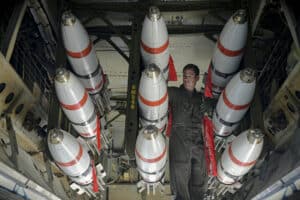
Each B-2 can carry up to 16 nuclear bombs (the B61-7, B61-11, and B83-1 gravity bombs), and each B-52 H can carry up to 20 air-launched cruise missiles (the AGM-86B). B-52H bombers are no longer assigned gravity bombs (Kristensen 2017c). An estimated 788 nuclear weapons, including approximately 500 air-launched cruise missiles, are assigned to the bombers, but only about 300 weapons are thought to be deployed at bomber bases. The estimated remaining 488 bomber weapons are thought to be in central storage at the large Kirtland Underground Munitions Maintenance and Storage Complex outside Albuquerque, New Mexico.
The United States is modernizing its nuclear bomber force by upgrading nuclear command-and-control capabilities on existing bombers, developing improved nuclear weapons (the B61-12 and the new AGM-181 Long-Range Standoff Weapon (LRSO), and designing a new heavy bomber (the B-21 Raider).
Upgrades to the nuclear command-and-control systems that the bombers use to plan and conduct nuclear strikes include the Global Aircrew Strategic Network Terminal. This is a new, high-altitude, electromagnetic pulse-hardened network of fixed and mobile nuclear command-and-control terminals. This network provides wing command posts, task forces, munitions support squadrons, and mobile support teams with survivable ground-based communications to receive launch orders and disseminate them to bomber, tanker, and reconnaissance air crews. First delivery of the Global Aircrew Strategic Network Terminals, which the Air Force describes as “the largest upgrade to its nuclear command, control and communication systems in more than 30 years,” was expected in May 2020. However, it appears that this was delayed until January 2022 when Barksdale Air Force Base first received the system (US Air Force 2022d).
Another command-and-control upgrade involves a program known as Family of Advanced Beyond Line-of-Sight Terminals, which replaces existing terminals designed to communicate with the MILSTAR military satellite constellation operated by the US Space Force. These new, extremely high frequency terminals are designed to communicate with several satellite constellations, including advanced extremely high frequency satellites. The 37 ground stations and nearly 50 airborne terminals of the Family of Advanced Beyond Line-of-Sight Terminals will provide protected high-data rate communication for nuclear and conventional forces, including for what is officially called “presidential national voice conferencing.” According to the Air Force (US Air Force 2019b), the Family of Advanced Beyond Line-of-Sight Terminals “will provide this new, highly secure, state-of-the-art capability for [Department of Defense] platforms to include strategic platforms and airborne/ground command posts via MILSTAR, [advanced extremely high frequency], and enhanced polar system satellites. [It] will also support the critical command and control … of the MILSTAR, [advanced extremely high frequency], and enhanced polar system satellite constellations.”
The heavy bombers are also being upgraded with improved nuclear weapons. This effort includes development of the first guided, standoff nuclear gravity bomb, known as the B61-12, which is ultimately intended to replace all existing gravity bombs. The bomb will use a modified version of the warhead used in the current B61-4 gravity bomb. B61-12 integration drop tests have already been conducted from the B-2 bomber. (The B61-12 will also be integrated onto US-and allied-operated tactical aircraft, including the F-15E, the F-16C/D, the F-16MLU, and the PA-200 Tornado.) Approximately 480 B61-12 bombs, which appear to have some limited earth-penetration capability, are expected to cost a total of roughly $10 billion (Kristensen and McKinzie 2016). The First Production Unit was initially scheduled for March 2020; however, in September 2019 a NNSA official confirmed that the B61-12 (as well as the upgraded W88 warhead for the Trident II SLBM) would likely face production delays due to concerns over the longevity of its commercial off-the-shelf subcomponents (Gould and Mehta 2019). The First Production Unit prototype of the B61-12 was completed by NNSA on August 25, 2020, at its Pantex Plant in Amarillo, Texas (National Nuclear Security Administration (NNSA) 2020a). The actual First Production Unit was completed only in November 2021, and NNSA confirmed in October 2022 that full-scale production had begun (NNSA 2022).
The Air Force is also developing a new nuclear air-launched cruise missile known as the AGM-181 Long-Range Standoff Weapon (LRSO). It will replace the AGM-86B air-launched cruise missile in 2030 and will carry the W80-4 nuclear warhead, a modified version of the W80-1 used in the current air-launched cruise missile. In February 2019, the US Nuclear Weapons Council authorized the development engineering phase (Phase 6.3) for the W80-4. The production engineering stage (Phase 6.4) was initially planned for December 2021, but was substantially delayed (US Department of Energy 2019b). In mid-2022, the NNSA announced that the W80-4ʹs First Production Unit is now scheduled for delivery before the end of FY 2027, instead of FY 2025 as originally planned. Production is scheduled to be completed in FY 2031 (Leone 2022b).
A solicitation invitation to defense contractors in 2015 listed three potential options for the LRSO engine: first, a derivative subsonic engine that improves on current engine technology by up to 5 percent; second, an advanced subsonic engine that improves on current technology by 15 percent to 20 percent; and third, a supersonic engine (US Air Force 2015). In August 2017, the Air Force awarded 5-year contracts of $900 million each to Lockheed Martin and Raytheon to develop design options for the missile. After reviewing the designs, the Air Force, in December 2019, cleared the two companies to continue development of the missile (Sirota 2019). The Air Force originally planned to down-select to a single contractor in FY 2022 during the awarding of the engineering and manufacturing development contract; however, in April 2020, the Air Force selected Raytheon Technologies as the prime contractor for the LRSO (US Air Force 2020c). This was a relatively surprising move, as selecting a single-source contractor at this early stage could ultimately result in higher program costs. In July 2021, Raytheon Technologies was awarded up to $2 billion to proceed with the engineering and manufacturing development stage of the LRSO, in order to prepare for full-rate production beginning in 2027 (Insinna 2021).
In March 2019, the Air Force awarded Boeing a $250 million contract to integrate the future LRSO onto the B-52Hs, a process that is expected to be completed by the beginning of 2025 (Hughes 2019). Development and production are projected to reach at least $4.6 billion for the missile (US Air Force 2019a) with another $10 billion for the warhead (US Department of Energy 2018a).
The missile itself is expected to be entirely new, with significantly improved military capabilities compared with the air-launched cruise missile, including longer range, greater accuracy, and enhanced stealth (Young 2016). This violates the 2010 White House pledge (White House 2010) that the “United States will not … pursue … new capabilities for nuclear weapons,” though the 2018 NPR and 2022 NPR eliminated such constraints.
Supporters of the LRSO argue that a nuclear cruise missile is needed to enable bombers to strike targets from well outside the range of the modern and future air-defense systems of potential adversaries. Proponents also argue that these missiles are needed to provide US leaders with flexible strike options in limited regional scenarios. However, critics argue that conventional cruise missiles, such as the extended-range version of the Joint Air-to-Surface Standoff Missile, can currently provide standoff strike capability, and that other nuclear weapons would be sufficient to hold the targets at risk. In fact, the conventional Extended-Range Joint Air-to-Surface Standoff Missile is now an integral part of US Strategic Command’s annual strategic exercises.
Unlike the current air-launched cruise missile, which is only carried by the B-52H bomber, the LRSO will be integrated on both the B-52H and new B-21 bombers. Northrop Grumman continues to develop the next-generation B-21 Raider heavy bomber, after its preliminary design review received Air Force’s approval in early 2017. In early 2022, the Air Force announced that six B-21 bombers were currently in production, and the first assembled bomber was taken to conduct its calibration tests in early March 2022 (Tirpak 2022a). The B-21 was previously scheduled to make its first flight no earlier than 2022 from its production facility in Palmdale, California, to Edwards Air Force Base about 30 miles (48 kilometers) up north (Wolfe 2020); however, this has since been delayed until 2023 (Tirpak 2022b). The B-21 is expected to enter service in the mid-2020s to gradually replace the B-1B and B-2 bombers during the 2030s (Tirpak 2022b). It is expected that the Air Force will procure at least 100 (possibly as many as 145) of the new bombers, with the latest service costs estimated at approximately $203 billion for the entire 30-year operational program, at an estimated cost of $550 million per plane (Capaccio 2021; Tirpak 2020). Further details about the B-21 program are still shrouded in secrecy, but in December 2022 the Air Force revealed the bomber during an official unveiling ceremony at Northrop Grumman’s production facilities (US Air Force 2022i). The design of the new B-21 bomber is very similar to the B-2ʹs but appears to be slightly smaller with a reduced weapons capability. The B-21 will be capable of delivering both the B61-12 guided nuclear gravity bomb and the future AGM-181 LRSO, as well as a wide range of non-nuclear weapons, including the Joint Air-to-Surface Standoff (JASSM) cruise missile.
The Air Force announced in March 2019 that the B-21 bombers will first be deployed at Ellsworth Air Force Base (South Dakota), followed by Whiteman Air Force Base (Missouri) and Dyess Air Force Base (Texas) “as they become available” (US Air Force 2019c). Construction at Ellsworth AFB began in 2022, and the base’s new Weapons Generating Facility, which will store and maintain nuclear bombs and cruise missiles, is scheduled to be completed by February 2026 (Tirpak 2022c). Ellsworth AFB is currently expected to host two B-21 squadrons (one operational squadron and one training squadron). However, according to South Dakota Senator Mike Rounds, a second operational squadron might eventually be stationed at Ellsworth Air Force Base as well in the future (News Center 1 2022).
The conversion of the non-nuclear B-1 host bases to receive the nuclear B-21 bomber will increase the overall number of bomber bases with nuclear weapons storage facilities from two bases today (Minot AFB and Whiteman AFB) to five bases by the 2030s (Barksdale AFB will also regain nuclear storage capability) (Kristensen 2020c).
Nonstrategic nuclear weapons
The United States has only one type of nonstrategic nuclear weapon in its stockpile: the B61 gravity bomb. The weapon currently exists in two versions: the B61-3 and the B61-4 with yields varying from 0.3 kilotons up to 170 and 50 kilotons, respectively. A third version, the B61-10, was retired in September 2016. Approximately 200 such tactical B61 bombs are currently stockpiled. About 100 of these (versions −3 and −4) are thought to be deployed at six bases in five European countries: Aviano and Ghedi in Italy; Büchel in Germany; Incirlik in Turkey; Kleine Brogel in Belgium; and Volkel in the Netherlands. This number has declined since 2009 partly due to reduction of operational storage capacity at Aviano and Incirlik (Kristensen 2015, 2019c). A seventh country — Greece — has a contingency nuclear strike mission and accompanying reserve squadron, but it does not host any nuclear weapons (Kristensen 2022c). The other 100 B61 bombs stored in the United States are for backup and potential use by US fighter-bombers in support of allies outside Europe, including Northeast Asia. The fighter-bombers include F-15Es from the 391st Fighter Squadron of the 366th Fighter Wing at Mountain Home in Idaho (Carkhuff 2021).
The Belgian, Dutch, German, and Italian air forces are currently assigned an active nuclear strike role with US nuclear weapons. Under normal circumstances, the nuclear weapons are kept under the control of US Air Force personnel; their use in war must be authorized by the US president. A 2022 NATO factsheet states that “a nuclear mission can only be undertaken after explicit political approval is given by NATO’s Nuclear Planning Group (NPG) and authorisation is received from the US President and UK prime minister” (NATO 2022a). However, it is unclear why the UK Prime Minister would have to authorize employment of US nuclear weapons, and unless NATO territory had been attacked with nuclear weapons first, it seems unlikely that the entire NPG would be able to agree on approving the employment of non-strategic nuclear weapons from bases in Europe.
The Belgian and Dutch air forces currently use the F-16 aircraft for the nuclear missions, although both countries are in the process of obtaining the F-35A to eventually replace their F-16s. The Italian Air Force uses the PA-200 Tornado for the nuclear mission but is in the process of acquiring the F-35A. Like the Tornados, the nuclear F-35As will be based at Ghedi Air Base, which is currently being upgraded. Germany also uses the PA-200 Tornado for the nuclear mission; however, it is planning to retire its Tornados by 2030, and would require a new dual-capable aircraft if it intended to remain part of NATO’s nuclear sharing mission. After previously leaning toward purchasing Boeing’s F/A-18E/F Super Hornet, the German government announced in March 2022 that it would instead purchase 35 Lockheed Martin F-35A aircraft to fulfill its nuclear mission (US Department of Defense 2022d).
At least until 2010, Turkey was still using F-16s for the nuclear mission, although it is possible that Turkey’s role has since been reduced to a contingency mission. In 2019, the Trump administration also halted delivery of F-35As to Turkey — some of which were intended to take over the nuclear mission — because of its plans to acquire the Russian S-400 air-defense system (DeYoung, Fahim, and Demirjian 2019). Legislators and analysts raised concerned about the security of the nuclear weapons at the Incirlik base during the failed coup attempt in Turkey in July 2016; the chairman of the Senate Foreign Relations Subcommittee for Europe stated in September 2020 that “our presence, quite honestly, in Turkey is certainly threatened,” and further noted that “we don’t know what’s going to happen to Incirlik” (Gehrke 2020). Despite rumors in late 2017 that the weapons had been “quietly removed” (Hammond 2017), the New York Times reported in 2019 that US officials had reviewed emergency nuclear weapons evacuation plans for Incirlik, indicating that that there were still weapons present at the base (Sanger 2019). This has been further reinforced by ongoing infrastructure work at nuclear weapon storage sites in Turkey (US Department of Defense 2022e). The number of nuclear weapons at Incirlik appear to have been reduced, however, from up to 50 to perhaps 20. If the United States decided to withdraw the remaining nuclear weapons from Incirlik, it could probably do so with a single C-17 transport aircraft from the 4th Airlift Squadron at Joint Base Lewis-McChord in Washington — the only unit in the Air Force that is qualified to airlift nuclear weapons.
NATO Member States that do not host nuclear weapons can still participate in the nuclear mission as part of conventional supporting operations, known as Support of Nuclear Operations With Conventional Air Tactics, or SNOWCAT.
NATO is working on a broad modernization of the nuclear posture in Europe that involves upgrading bombs, aircraft, and the weapons storage system (Kristensen 2022c). The B61-12 is estimated to be 12 feet long, weighing approximately 825 pounds, and is designed to be air-launched in either ballistic or gravity drop modes (Baker 2020). The B61-12 will use the nuclear explosive package of the B61-4, which has a maximum yield of approximately 50 kilotons and several lower-yield options. However, it will be equipped with a guided tail kit to increase accuracy and standoff capability, which will allow strike planners to select lower yields for existing targets to reduce collateral damage. The increased accuracy of the B61-12 will give the tactical bombs in Europe the same military capability as strategic bombs used by the bombers in the United States. Although the B61-12 has not been designed as a designated earth-penetrator, it does appear to have some limited earth-penetration capability. This increases its ability to hold at risk underground targets (Kristensen and McKinzie 2016). Until their purchased new F-35A aircraft are ready, Italy and Germany will continue to fly the PA-200 whereas Belgium and the Netherlands will continue to fly the F-16MLU. But because of their age and logarithmic systems, these aircraft will not be able to benefit from the increased accuracy provided by the B61-12ʹs new digital guided tail kit. Instead, it will deliver the bomb as a “dumb” bomb akin to the current B61-3s and B61-4s.
In March 2020, the F-15E became the first aircraft to be certified to operate the B61-12 bomb after completing the last in a series of six compatibility tests at Nellis Air Force Base and the Tonopah Test Range (Baker 2020). In addition to the F-15E aircraft, the integration of the B61-12 on B-2, F-16, and PA-200 aircraft is well under way. In October 2021, the F-35A completed two drop tests of the B61-12 Joint Test Assembly, thus completing the final stage of its nuclear design certification process (US Air Force 2021b).
The new B61-12 bomb began full-scale production in the fall of 2022 and is expected to be completed by 2026 (Sandia National Laboratories 2022). It is expected to complete certification with the F-35A aircraft before January 2023, followed by training of the nuclear fighter-wings in Europe later in 2023 (Defense Visual Information Distribution Service 2022a). Once deployment to Europe begins, the B61-3/4 bombs currently deployed in Europe will be returned to the United States. A report that delivery of the B61-12 to Europe had been pushed up to December 2022 (Bender, McLeary, and Banco 2022) was denied by the Department of Defense (Johnson 2022).
NATO is life-extending the weapons storage security system, which involves upgrading command and control, as well as security, at the six active bases (Aviano, Büchel, Ghedi, Kleine Brogel, Incirlik, and Volkel) and one training base (Ramstein). Specifically, these upgrades include the installation of double-fence security perimeters, modernizing the weapon storage and security systems and the alarm communication and display systems, and the operation of new secure transportation and maintenance system trucks (Kristensen 2021b). Security upgrades now appear to have been completed at Aviano, Incirlik, and Volkel, and are underway at Ghedi, Kleine Brogel, and Büchel. Additionally, it appears that an air base in the United Kingdom — believed to be RAF Lakenheath — has been quietly added to the list of bases receiving nuclear weapon storage site upgrades (US Department of Defense 2022e). The upgrade comes as RAF Lakenheath is preparing to become the first US Air Force base in Europe equipped with the nuclear-capable F-35A Lightning aircraft. This development does not necessarily indicate that the United Kingdom will once again host US nuclear weapons (the last US nuclear weapons were withdrawn from UK soil in 2008), especially given that NATO Secretary General Jens Stoltenberg stated as recently as December 2021 that “we have no plans of stationing any nuclear weapons in any other countries than we already have … ” (NATO 2021). However, the upgrade could be intended to give NATO the option to redistribute its nuclear weapons in times of heightened tensions, or to potentially move them out of Turkey in the future.
In addition to the modernization of weapons, aircraft, and bases, NATO also appears to be increasing the profile of the dual-capable aircraft posture. In June 2020, for example, the 31st Fighter Wing at Aviano Air Base conducted the first “elephant walk” ever to display all aircraft in a single visual show of force of its capability to “deter and defeat any adversary who threatens US or NATO interests” (US Air Force 2020d). Additionally, NATO’s annual Steadfast Noon nuclear force exercise includes participation from many NATO members every year. In 2022, the exercise involved the participation of 14 countries — including fourth-generation F-16s and F-15Es as well as fifth-generation F-35A and F-22 from NATO host countries, as well as US B-52 long-range bombers from Minot Air Base — centered at Kleine Brogel Air Force Base in Belgium (NATO 2022b; Kristensen 2022c).
A new non-strategic nuclear weapon, the sea-launched cruise missile (SLCM-N) proposed by the Trump administration’s Nuclear Posture Review in 2018, was canceled by the Biden administration’s 2022 Nuclear Posture Review (this weapon is discussed in greater detail in a previous section, see “The Nuclear Posture Review and nuclear modernization”).
Disclosure statement
No potential conflict of interest was reported by the authors.
Funding
This research was carried out with generous contributions from the John D. and Catherine T. MacArthur Foundation, the New-Land Foundation, Ploughshares Fund, the Prospect Hill Foundation, the FTX Future Fund and Longview Philanthropy, the Stewart R. Mott Foundation, the Future of Life Institute, Open Philanthropy, and individual donors.
Together, we make the world safer.
The Bulletin elevates expert voices above the noise. But as an independent nonprofit organization, our operations depend on the support of readers like you. Help us continue to deliver quality journalism that holds leaders accountable. Your support of our work at any level is important. In return, we promise our coverage will be understandable, influential, vigilant, solution-oriented, and fair-minded. Together we can make a difference.







